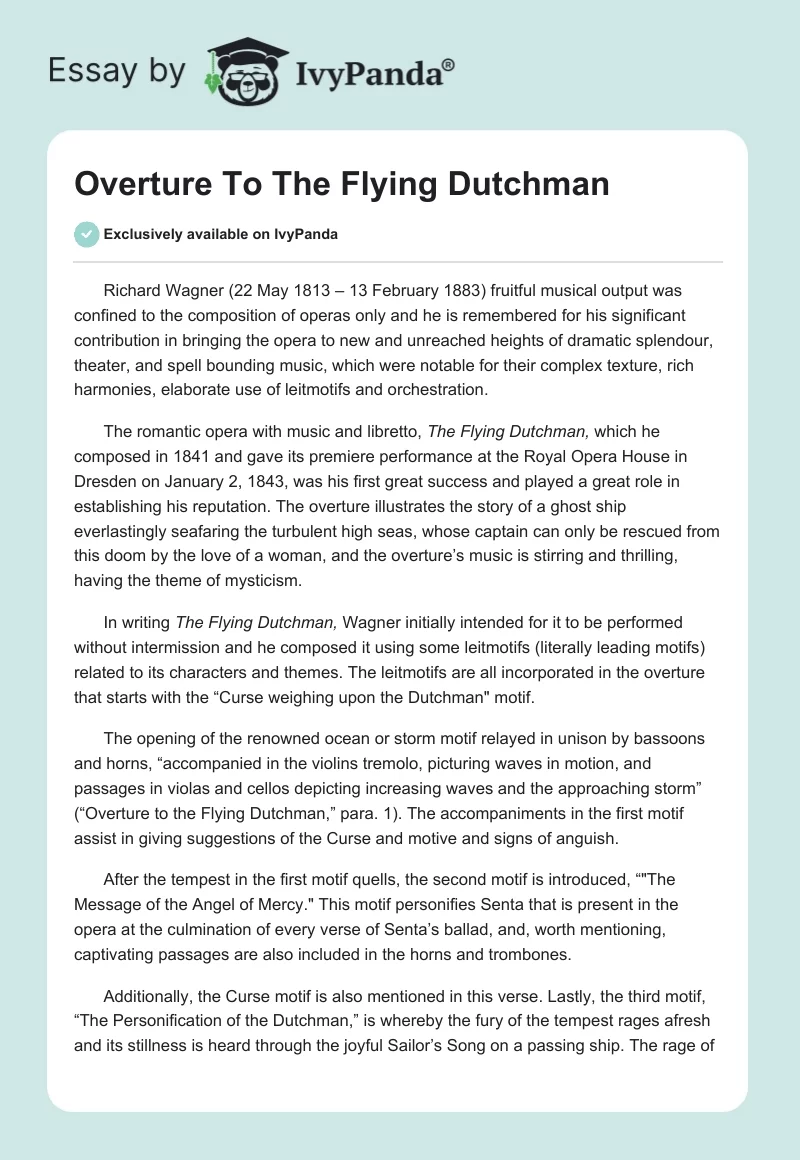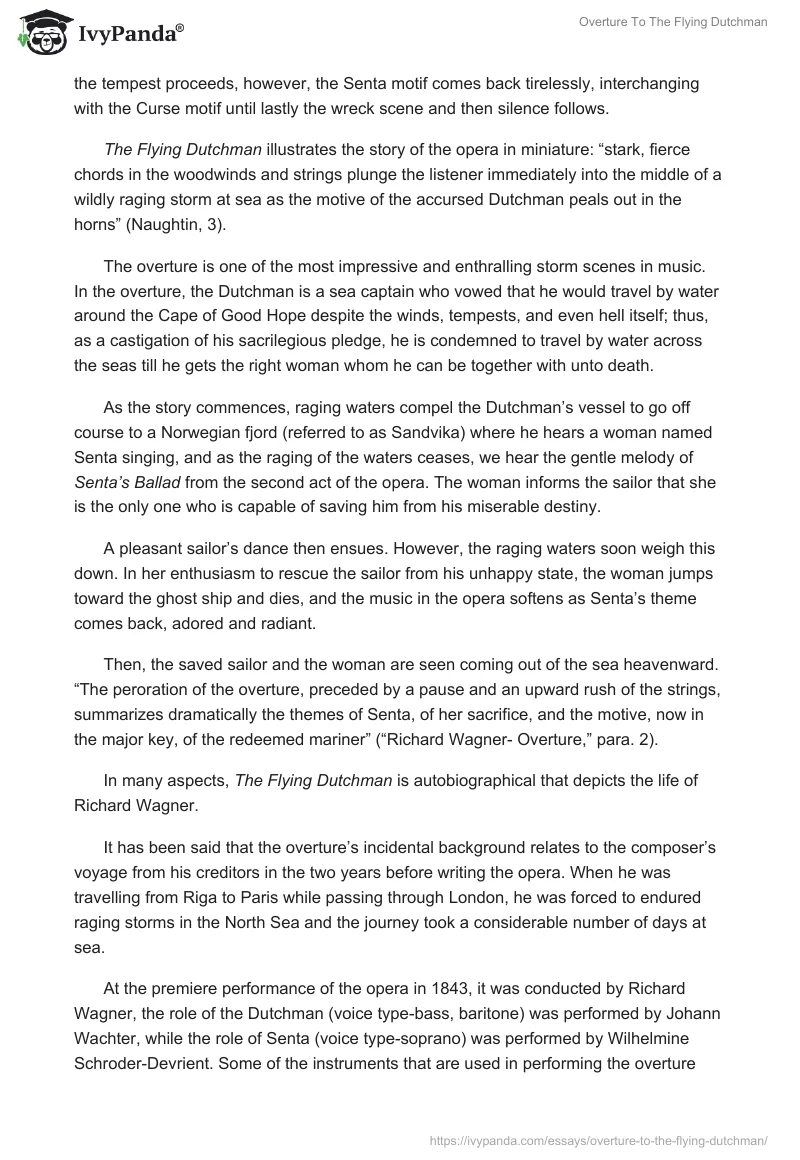Richard Wagner (22 May 1813 – 13 February 1883) fruitful musical output was confined to the composition of operas only and he is remembered for his significant contribution in bringing the opera to new and unreached heights of dramatic splendour, theater, and spell bounding music, which were notable for their complex texture, rich harmonies, elaborate use of leitmotifs and orchestration.
The romantic opera with music and libretto, The Flying Dutchman, which he composed in 1841 and gave its premiere performance at the Royal Opera House in Dresden on January 2, 1843, was his first great success and played a great role in establishing his reputation. The overture illustrates the story of a ghost ship everlastingly seafaring the turbulent high seas, whose captain can only be rescued from this doom by the love of a woman, and the overture’s music is stirring and thrilling, having the theme of mysticism.
In writing The Flying Dutchman, Wagner initially intended for it to be performed without intermission and he composed it using some leitmotifs (literally leading motifs) related to its characters and themes. The leitmotifs are all incorporated in the overture that starts with the “Curse weighing upon the Dutchman” motif.
The opening of the renowned ocean or storm motif relayed in unison by bassoons and horns, “accompanied in the violins tremolo, picturing waves in motion, and passages in violas and cellos depicting increasing waves and the approaching storm” (“Overture to the Flying Dutchman,” para. 1). The accompaniments in the first motif assist in giving suggestions of the Curse and motive and signs of anguish.
After the tempest in the first motif quells, the second motif is introduced, “”The Message of the Angel of Mercy.” This motif personifies Senta that is present in the opera at the culmination of every verse of Senta’s ballad, and, worth mentioning, captivating passages are also included in the horns and trombones.
Additionally, the Curse motif is also mentioned in this verse. Lastly, the third motif, “The Personification of the Dutchman,” is whereby the fury of the tempest rages afresh and its stillness is heard through the joyful Sailor’s Song on a passing ship. The rage of the tempest proceeds, however, the Senta motif comes back tirelessly, interchanging with the Curse motif until lastly the wreck scene and then silence follows.
The Flying Dutchman illustrates the story of the opera in miniature: “stark, fierce chords in the woodwinds and strings plunge the listener immediately into the middle of a wildly raging storm at sea as the motive of the accursed Dutchman peals out in the horns” (Naughtin, 3).
The overture is one of the most impressive and enthralling storm scenes in music. In the overture, the Dutchman is a sea captain who vowed that he would travel by water around the Cape of Good Hope despite the winds, tempests, and even hell itself; thus, as a castigation of his sacrilegious pledge, he is condemned to travel by water across the seas till he gets the right woman whom he can be together with unto death.
As the story commences, raging waters compel the Dutchman’s vessel to go off course to a Norwegian fjord (referred to as Sandvika) where he hears a woman named Senta singing, and as the raging of the waters ceases, we hear the gentle melody of Senta’s Ballad from the second act of the opera. The woman informs the sailor that she is the only one who is capable of saving him from his miserable destiny.
A pleasant sailor’s dance then ensues. However, the raging waters soon weigh this down. In her enthusiasm to rescue the sailor from his unhappy state, the woman jumps toward the ghost ship and dies, and the music in the opera softens as Senta’s theme comes back, adored and radiant.
Then, the saved sailor and the woman are seen coming out of the sea heavenward. “The peroration of the overture, preceded by a pause and an upward rush of the strings, summarizes dramatically the themes of Senta, of her sacrifice, and the motive, now in the major key, of the redeemed mariner” (“Richard Wagner- Overture,” para. 2).
In many aspects, The Flying Dutchman is autobiographical that depicts the life of Richard Wagner.
It has been said that the overture’s incidental background relates to the composer’s voyage from his creditors in the two years before writing the opera. When he was travelling from Riga to Paris while passing through London, he was forced to endured raging storms in the North Sea and the journey took a considerable number of days at sea.
At the premiere performance of the opera in 1843, it was conducted by Richard Wagner, the role of the Dutchman (voice type-bass, baritone) was performed by Johann Wachter, while the role of Senta (voice type-soprano) was performed by Wilhelmine Schroder-Devrient. Some of the instruments that are used in performing the overture include two flutes, piccolo, two oboes, four French horns, two trumpets, timpani, and violins.
Works Cited
Naughtin, Mathew. “Overture to The Flying Dutchman.” Wagner. 2002. Web.
“Overture to the Flying Dutchman.” Music with Ease. 2011. Web.
“Richard Wagner- Overture.” Old and Sold, n.d. Web.


